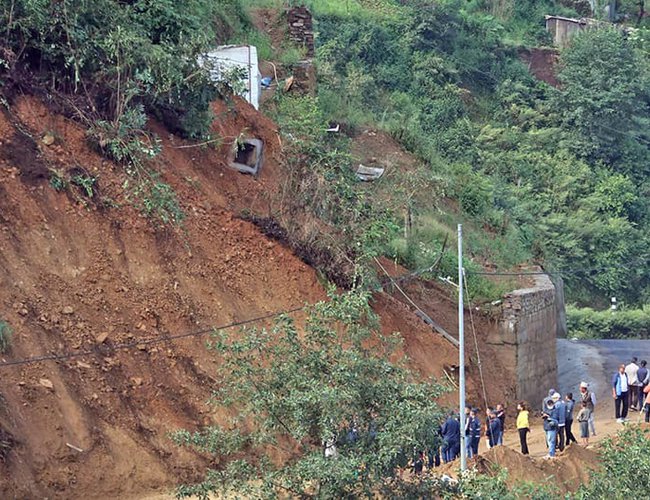
The recently occurred 6.4 magnitude earthquake and aftershocks took life of 153 people out of which 101 deaths were reported from Jajarkot and 52 deaths were reported from Rukum West. Nepal is noted to be one of the most disaster prone countries in the world. Earthquakes, climate change, floods and landslides are regular items of hazard menu of the country. The roars of the three tiers of government echo with the six layers of disaster risk reduction and management institutions as provisioned in the Disaster Risk Reduction and Management Act 2017 and their ambit of functionalities, in theory, to address hazards preventing them from turning into disasters. The Article 47 of the DRRMA 2017 confers power to introduce new guidelines, rules and regulations to address hazards and disasters and thereby 'Disaster Risk Reduction and Management Rules 2019' was established. The institutions envisioned represent from federal level to local level and are expected to be extended to ward levels also. However, whenever the hazards turn into disasters whether of local or provincial or national levels, these many institutions often appear little more than functional and appear primarily acting as the agencies of rescue and reliefs.
In post-disaster situations, working in the areas of rescue and reliefs are paramount and prominently relevant. Looking for missing people, finding them and ensuring their safety at the earliest possible time-span is very important life line for saving lives of people trapped in the disasters. Providing reliefs such as food, water and shelter as an immediate supports to minimize and avoid further risks associated with health conditions of disaster affected people or survivors is at the heart of saving lives. Access to clean water, healthy food, and safe shelter inclusive of medical services are very important during and post disaster situations, especially when the disasters disrupt electricity, internet and communication channels, fuel supply, transportation system and life-line livelihood practices. The incidents also further complicate relief efforts therefore timely disaster reliefs are about saving lives of people under post-disaster trauma and sufferings.
However, the disaster story does not begin and end with rescue and relief activities alone. Instead, it begins with the theory of disaster risk reduction and ends with reconstruction and recovery. The Natural Calamity (Relief) Act of Nepal was a noble legal framework to conduct rescue and provide reliefs in post-disaster situations and it was established in 1982. A similar, but may be a bit farther sighted global architecture known as The Hyogo Framework for Action (HFA) was adopted at the World Conference on Disaster Reduction in January 2005 by 168 member states of the United Nations. It was a ten year global architecture from 2005 to 2015 and was more focused on disaster management therefore its successor—the Sendai Framework for Disaster Risk Reduction 2015-2030. The title, itself, of the existing global architecture is more appealing and clearly indicates that it is about Disaster Risk Reduction not only about disaster management. Let me provide a distinction between Disaster Management and Disaster Risk Reduction for conceptual clarity here in brief. Disaster Management primarily considers about post-disaster situations associated with rescue, relief, reconstruction and recovery while Disaster Risk Reduction focuses on pre-disaster, during disaster and post-disaster circumstances and realities. The DRR activities include from preparedness, mitigation, rescue, and relief to recovery, reconstruction to resurgence of societies to normalcy.
The fundamental reason behind making the Natural Calamity Act of 1982 null and void after introducing the Disaster Risk Reduction and Management Act of 2017 was that the former focused only on post-disaster management while the latter on all from pre to during to the post-disaster situations. While many components of Sendai Framework have been captured in the Disaster Risk Reduction and Management Act 2017 with elaborated six layers of institutions from National Council to Executive Committee to National Authority to Provincial Executive Committee to District Disaster Management Committee to Local Disaster Management Committee, the responses being made after 2017 dealing with every disaster occurring in the country demonstrate thebelittled the role of the 2017 Act and its institutions provisioned from the top to the bottom, from national level to local level. The Sendai Framework provisions seven clear targets and four priorities for action to prevent forthcoming hazards from turning into disasters and to reduce the impacts of disaster risks if occurred. The four key priorities to achieve its targets include (i) Understanding disaster risk; (ii) Strengthening disaster risk governance to manage disaster risk; (iii) Investing in disaster reduction for resilience and; (iv) Enhancing disaster preparedness for effective response, and to "Build Back Better" in recovery, rehabilitation and reconstruction. The framework aims to achieve a substantial reduction of disaster risks and losses in lives, livelihoods and health, and in the economic, physical, social, cultural and environmental assets of persons, businesses, communities and countries over the next 15 years i.e. until 2030.
The Disaster Risk Reduction and Management Act of 2017 was also brought to life, aligning it with the priorities of the global architecture, the Sendai Framework, and the contextualized and localized needs of time and actions but it hardly fulfils the first two out of the four priorities of the global architecture. It appears that Nepal is making efforts to align with the first and second priorities only; while the third and fourth priorities of the global architecture still remain far from realities in all aspects, from philosophysizing, understanding, and actualization. There is very little investment in preparedness and mitigation for preventing hazards turning into disasters. This becomes apparently clear when we investigate the budget percentage allocated for DRRM from federal to local level governments. The local communities are not made aware about the frequently occurring hazards at the level of internalization and they are also not trained against such hazards in term of taking steps for community preparedness and mitigation. In between the actions such as preparedness and mitigation, the practice of having Emergency Kit or Civil Defense Kit (in Nepal BibatJhola) having food, water and other emergency items to last for about three days is a priority across many countries of the world along with emergency assembly points, there are far from realities across all the household and even government offices of Nepal. After every hazard when it turns into disaster, the survivors have to wait for both relief and rescue from external actors because they are not trained and equipped well, in the first instant, from preventing the hazards turning into disasters and in the second instant, community preparedness when disasters occur. The greater inefficiencies are often shown by the three tiers of governments as they significantly fail to provide timely rescue and relief services to the survivors, keeping the process of recovery and reconstruction to bring the communities into normalcy far at the distant. Such frequent failures must demand the six layers of Disaster Risk Reduction and Management Institutions first to prepare and equip them well, keeping themselves active in normal situations, engaging them in the preparedness and mitigation actions and in, during and post disaster situations, ready to handle the all necessary actions that come along to bring the society back to normalcy from post-disaster situations. If failures persist, there is no reason to roar and echo that Nepal has six layers of institutions to deal with Disaster Risk Reduction and Management. Civil society organizations working in the areas of disaster risk reduction and managementcan also collaborate and contribute to reducing hazards and preventing them from becoming disasters.
Dr. Chandra Lal Pandey is an Associate Professor and the Head of the Department of Development Studies Kathmandu University. He can be reached at: chandra.pandey@ku.edu.np
- 16thPeriodic Plan for Delivering Basic Services and Fundamental Rights?
- Feb 08, 2024
- Haphazard Urbanization Or Sustainable Smart Cities In Nepal?
- Jun 28, 2023
- Say No To Pre-Election Coalition
- Jul 14, 2022
- Nepalis Are Optimistic:Findings Of SNP 2020
- Apr 12, 2021
- Corruption: Practices & Remedies
- Oct 02, 2020

















